At the beginning of March, the trainees made our way to Newnham College for a tour around their college library. Newnham was founded in 1871 as a residence for women attending lectures at the university (long before they could become full members in 1948) and to this day, remains a women-only college.
After arriving at the library we were met by last year’s trainee, who has stayed on at Newnham in the role of Special Collections Project Library Assistant. It’s always nice to hear about which jobs ex-trainees have gone on to do! First we were taken into the library lobby, where the library assistant explained to us that the library is open from 6.30am-1.45am in order to encourage students to get some sleep. This seems to be a common reoccurrence in many college libraries – whilst some are open 24/7, others believe that this can promote an unhealthy work-sleep balance and that students would regularly pull all-nighters unless they are physically locked out of the library! The library assistant also showed us the hand-bound library guides and her new book display which we were all very impressed to hear is updated every day! It certainly beats my mass-printed guides and once-a-month display changes at my own college library…
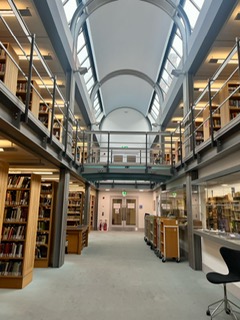
We were next shown a board which was covered in bookmarks that are given to each student in their first year, which they can then write book recommendations on and stick up. This contributed to the sense of community which was felt throughout the library, possibly due to the college’s history of being a safe space for those excluded from the university and its current status as a women-only college. The library has a book exchange, a women’s and LGBT+ collection curated by the JCR, and features displays put together by current students. Our favourite example of the Newnham community spirit, however, had to be the Library Knitting Box – I think we’re all tempted to return to Newnham at some point to take part in their regular knitting nights!
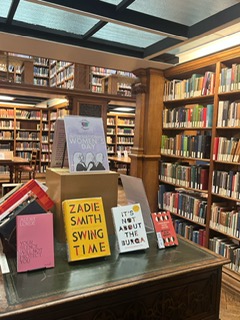
As well as the academic books kept for students, the library has a ‘shelf-help’ section which works on the basis of anonymous borrowing and contains books on welfare and study guides. There is also a section with graphic novels, modern fiction, modern poetry and periodicals. As is becoming a common concern in libraries, the library assistant explained to us that they had been unsure whether the periodicals were actually being used. She showed us her ingenious yet simple solution – a quick survey put up in the periodicals area where patrons put a tick next to the name of the periodicals they used. Surprisingly this demonstrated that they were far more popular than she had thought! Less surprising though was the fact that she mentioned they had lots of old journals to get rid of. I know in my own library we’re having discussions about whether years’ worth of journals are a practical use of space, given feedback suggests that the vast majority of students only access these online. A slightly random addition to the library is Blaise Pascal’s death mask (which apparently has its own BeReal account?) – the library assistant revealed that some students prefer to work with it watching over them. I suppose whatever encourages you to finish that essay!
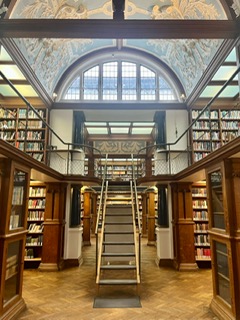
We were next taken into the old half of the library – a Grade II* listed building which we were all very pleased to hear houses the humanities books as well as various collections. These include the Bloomsbury collection, which contains first edition works and related items by Virginia Woolf, and the Rogers collection, which contains children’s literature. Originally donated to Newnham as a joke in the early 20th century – the implication being that, as women, this was all the students were capable of reading – this collection includes folktales and fairy tales from around the world. The main collection is classified with an in-house scheme that is loosely based on the Library of Congress classification scheme. The advantage of this is that the classmarks can be adapted as the collection evolves, such as by adding a 21st century section. The ceiling of the old library is especially impressive, with panels displaying different printers’ marks. We were equally delighted to see a replica of a banner that was taken by Newnham and Girton students to suffragette marches – one of many reminders found in the library of Newnham’s history of supporting women’s rights and education.
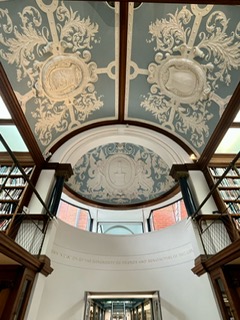
The library assistant then showed us something very special – an exhibition which had just been installed, making us the first people to see it! She explained that during her trainee year, she had spent a lot of time with the Jaffé collection (Patricia Jaffé being a Research Fellow from 1962 who was also an accomplished wood engraver). This collection was donated by Jaffé’s family in 2022 and has around 450 books, featuring illustrations by 20th and 21st century women wood engravers. The exhibition features a selection from this collection and the library assistant gave us an extremely informative talk about her choices, as well as the art of wood engraving itself. I can now safely say I know the difference between a woodcut and a wood engraving! My personal favourite item in the exhibition was a small toy horse belonging to a current fellow at Newnham. Nora Unwin, a wood engraver, had lived with her family during the war and, during this time, had written and illustrated a book about the horse, which is also featured in the exhibition.
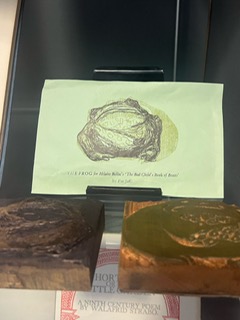

Following our visit to the exhibition, it was time for some hard-earned tea and biscuits in the library kitchen. Discussions ranged from tips from the library assistant on planning exhibitions (I will definitely be taking her advice on making a to-scale diagram!), to the history of Braille, to some interesting items found by one of the trainees in some manuscripts they had been going through (as well as speculation on how said items may have got there). To finish the afternoon we went for a walk through Newnham’s beautiful gardens in order to find the house where Sylvia Plath had lived in as a student – we are mainly ex-English students after all!
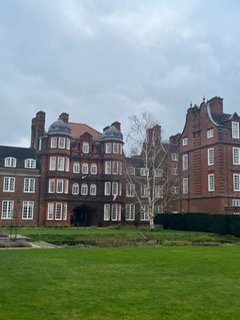
We would like to thank the Special Collections Project Library Assistant for such an engaging and informative tour, as well as the whole library team at Newnham for allowing us to spend our afternoon in their gorgeous library.
